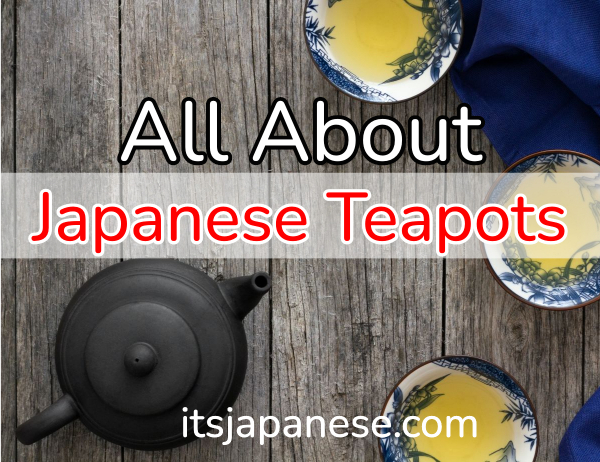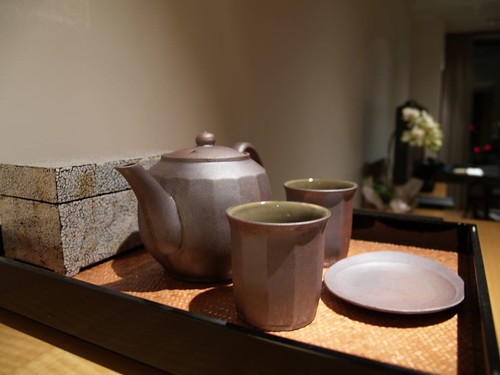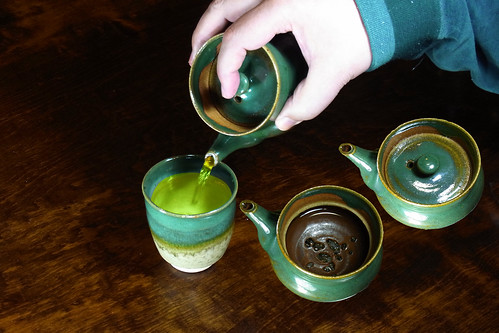Want to learn a bit about Japanese teapots?
In this guide, you’ll cover….
- Introduction to Japanese Teapots
- The 4 Types
- When the Teapots are Used
- How to Prepare Tea the Japanese Way
So, let’s jump in!

1. Introduction to Japanese Teapots
You probably already know this but…
Japan is a tea-drinking country. Most people drink tea at least once per day. So, because tea is so popular, the equipment for brewing — like teapots — is also important.
The teapot in Japan is called a kyuusu and has been in the culture for a long, long time — although it originates from China. Most Japanese people use the “kyuusu” to brew Japanese green tea, serve guests tea with the teapot, and as such so… you’ll find it in almost every Japanese home. The teapots themselves are usually ceramic because it retains heat well.
Is there any difference between Japanese teapots and other teapots? Sure. The Japanese teapots fit less water and look smaller than the western teapots. Why? Less space means it’s easier to brew tea multiple times with the same tea leaves.
Although there are many Japanese teapot designs, the side handle type is the most iconic teapot of Japan.
So, if you want some teapots for yourself, check them out on Amazon via the link below.
But, if you don’t know which to get… take a look below.
We’ll cover the types of teapots there are.
2. Types of Japanese teapots
Now, let’s talk about the different types of Japanese teapots.
A) Yokotegata (side handle teapot)
A type of teapot unique to Japan is the yokotegata type, and it is one of the most traditional Japanese teapots. It looks like there is a horizontal handle sticking out of the side. What’s distinct about this teapot is that you can easily hold the teapot with one hand while placing your other hand on the lid. The side handle can help you get all the water out quickly and into the cups.
B) Ushirotegata (back handle teapot)
The ushirotegata or back handle type of teapot is common around the world. The back handle teapot has a curved handle attached to the back. It is easy to pour the tea when guests sit across from you. Japanese ushirotegata teapots tend to have a squished design, and it’s not as tall and round as a western-style teapot. It is a flatter shape so that it condenses the size of the teapot and uses less water.
C) Uwategata (top handle teapot)
The top handle type of teapot can fit more water than the other two types of teapots. It’s common in cafeterias where many people will be drinking tea. The top handle makes it easier to hold and pour when heavy. You should use lower-grade teas that are not as sensitive to water temperature for this particular teapot. You’ll need to put a large amount of boiling water let the tea brew in a less controlled environment.
D) Houbin (handleless teapot)
Houbin teapots are small teapots with no handle, and their name means “treasure bottle.” Since they have no handle, the water in the teapot can’t be too hot. It is perfect for premium-grade teas that require low temperatures like gyokuro. It’s not as common as the other three types of teapots, but you may find Houbin in Kyoto, where premium-level Japanese green teas are popular.
3. When to use Japanese Teapots
The best use for your Japanese teapot is to brew… green tea!
Why green tea? Well, in Japan, the word tea is synonymous with green tea. If you think it’s strange that there is only one kind of tea in Japan, well, there are different types of Japanese tea — all green! For example, you could try hojicha, gyokuro, genmaicha, or sencha, all made from green tea but with distinct flavor profiles.
So, Japanese teapots are suited for making green tea because of their smaller design and the ability to pour out all of the water each time you brew the tea.
Also, Japanese teapots are perfect for when you have guests over. This is because you can brew multiple times with the same tea leaves. As you enjoy some pleasant conversation, you can continue to refill the teapot and enjoy sipping the tea.
4. How to Prepare Tea with a Teapot
As you already know…
You’ll likely be brewing green tea with your Japanese teapot.
You’ll need about two teaspoons of tea leaves per cup of water. Most Japanese people don’t measure it, so it’s okay to approximate. As you brew more and more tea, you’ll figure out your own preferences.
For green tea, the water temperature should be around 175 F or 80 C. Since Japanese teas require lower temperatures, a yuzamashi or separate ceramic container to cool the boiling water is helpful. Check the specific tea packaging about the measurement and water temperature suggestion for the best result.
To brew the tea, put the measured tea leaves into the teapot. Pour the hot water until the teapot is full. Steep for 1- 3 minutes. To pour the tea, pour small amounts in each cup and cycle through the cups multiple times to distribute the tea strength evenly. You can refill the teapot and brew about four more rounds of tea with the old tea leaves. Make your steep time about 30 seconds less each time when doing this.
- Recap
- You’ll be likely brewing green tea
- 2 teaspoons of tea leaves per cup of water
- Water temperature should be 175 F (80 C)
- Put tea leaves in first
- Add water ’til teapot is full
- Steep for 1-3 minutes
- Pour small amounts in each cup
- Cycle through the cups to distribute tea strength evnely
Done!
Now, you know a bit about Japanese tea pots…
How to make Japanese tea (in other words, green tea) with the pots…
And what different types are.
Now, over to you. Do you have any teapots of your own?
Leave a comment.




